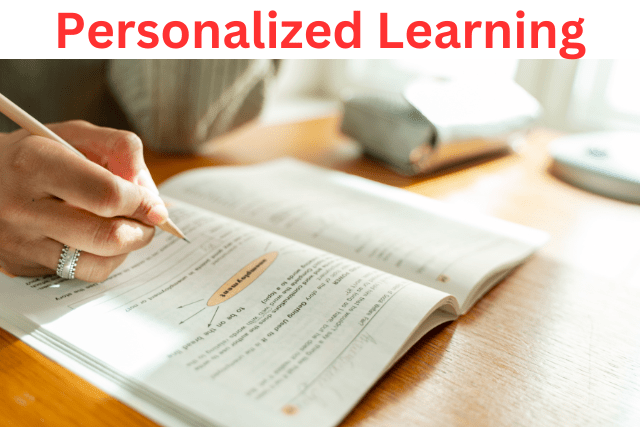Unlocking the potential of every student is at the core of effective education. As educators, we strive to provide personalized learning experiences that cater to each individual’s unique needs and abilities. Enter personalized learning – a revolutionary approach that adapts education to suit the specific requirements of students. By harnessing technology and innovative teaching methods, personalized adaptive learning has emerged as a game-changer in classrooms around the world. In this blog post, we will explore what personalized learning entails, its benefits for students, and how it can transform traditional education into a dynamic and tailored experience for all learners. So buckle up as we dive into the fascinating realm of personalized learning!
How Can Personalized Learning Be Beneficial To Students?
Personalized learning holds immense potential in transforming the educational landscape for students. By tailoring instruction to individual needs, it provides a host of benefits that can enhance their learning experiences and outcomes.
Personalized learning recognizes that every student is unique with different strengths, weaknesses, and interests. By adapting teaching methods and content to match their specific requirements, students are empowered to take ownership of their education. This not only boosts motivation but also fosters a deeper level of engagement with the material.
Students can learn at their own pace thanks to personalised learning. No longer bound by rigid timelines or predetermined milestones, learners have the freedom to progress at a speed that suits them best. This flexibility enables those who grasp concepts quickly to delve into more advanced topics while giving others the opportunity for additional support and reinforcement when needed.
Additionally, personalized learning promotes critical thinking skills by encouraging students to explore topics from various angles and perspectives. It encourages inquiry-based approaches where learners actively seek answers rather than passively receiving information. This cultivates higher-order thinking skills such as problem-solving, analysis, and creativity.
Moreover, personalized learning helps foster independence and self-directedness in students. By allowing them choices regarding what they learn and how they demonstrate understanding, it nurtures autonomy and decision-making skills – qualities essential for lifelong success.
Personalized learning brings forth a multitude of benefits for students, revolutionizing their educational journey and fostering improved outcomes. This approach, which tailors learning materials and methods to individual preferences and needs, creates a more engaging and effective learning atmosphere. Integrating USSD codes into this equation further amplifies these advantages in various ways. With personalized learning, students can embark on customized learning paths, pacing themselves according to their skill levels, and utilizing USSD codes to access specific modules aligned with their understanding. This individualized attention ensures that students receive precisely what they require, promoting independent learning while catering to their unique strengths and areas for improvement.
The integration of USSD codes into personalized learning also bolsters student engagement. These codes allow students to conveniently access bite-sized educational content, catering to their schedules and attention spans, which often favor shorter, focused interactions. Importantly, USSD-enabled learning content is accessible via basic mobile phones, democratizing education by transcending technology barriers. Real-time feedback mechanisms made possible through USSD, provide students with immediate responses to assessments, quizzes, and exercises, empowering them to identify their strengths and areas of growth.
Furthermore, the flexibility and convenience of personalized learning with USSD codes enable students to learn on the go, fitting education into their daily routines. This adaptability facilitates motivation and autonomy, as students feel a greater sense of control over their learning experiences. By offering content in various formats, including text, audio, and video, USSD-enabled personalized learning addresses diverse learning styles, ensuring that every student can comprehend and absorb information optimally.
What Is Personalized Adaptive Learning?
Personalized adaptive learning is an education method that caters to each student’s unique needs. It ditches the one-size-fits-all model in favor of tailored instruction. Technology is pivotal here, as adaptive software gathers data on students and adjusts teaching in real time. This doesn’t just mean changing content or speed; it also considers learning styles, interests, and goals. For instance, if a student’s great at math but struggles with reading, the system offers specific resources for improving reading.
This empowers students to control their education, pacing, and explore passions. They get custom feedback from teachers, boosting engagement. Overall, personalized adaptive learning transforms education by making it student-centric. Through technology, individual needs are met, paving the way for inclusive classrooms and empowered learners.
How Do You Personalize Learning For Students?
Personalizing learning tailors education to student’s unique needs, interests, and abilities. This acknowledges diverse learning styles, offering flexible resources like textbooks or online tools. Technology aids with personalized feedback, adaptive assessments, and interactive content. Teachers use differentiated instruction, adjusting methods based on students’ needs. Strong teacher-student relationships enhance personalization, aligning lessons with individual interests and goals. This connection builds trust and motivation, fostering academic and emotional success. Personalized learning promotes autonomy, and critical thinking, and readies students for adaptable real-world scenarios, emphasizing uniqueness and preparing for diverse challenges.
Collect and analyze the “Vi Last 5 Call Details” to understand the student’s communication habits. This data can include call duration, frequency, time of day, and the most contacted individuals.
Identify Patterns:
Look for patterns in the call details. For instance, if a student frequently communicates during certain hours, you can schedule learning activities during their most active times.
Adapt Learning Schedule:
Use the insights from the call details to adjust the learning schedule. If the student’s prime communication time is in the evening, allocate study sessions or assignments during that period.
Customized Content:
Tailor learning materials to align with the student’s interests and communication preferences. For instance, if they often talk about sports, include sports-related examples or scenarios in lessons.
Varied Communication Channels:
If the student frequently communicates using specific media (calls, messages, etc.), incorporate similar communication channels into the learning process. This could involve sending reminders or study tips via messaging apps.
What Learning Is Tailored To An Individual Students Needs?
In modern education, personalized learning caters to individual student needs. Recognizing unique strengths, weaknesses, and learning styles, it replaces the old one-size-fits-all approach. Tailored to abilities, interests, and goals, it offers custom instruction and resources. This method acknowledges diverse learning paces and styles.
Adaptive technology is one way to tailor learning. Digital tools adapt content based on progress. For instance, excelling in math but struggling in reading leads to adjusted math exercises and extra reading support.
Differentiated instruction is another method. Teachers vary strategies, materials, and assessments to meet diverse needs. They may group by skill or offer alternative assignments to suit interests and preferences.
Project-based learning personalizes by letting students explore passions, fostering critical thinking and problem-solving.
What Are The Benefits Of Personalized?
Benefits of Personalized Learning
Personalized learning offers numerous benefits for students, allowing them to thrive in an educational environment that caters to their individual needs and preferences. One of the key advantages is that it promotes self-paced learning, enabling students to progress at a speed that suits them best. This approach ensures that no student feels left behind or held back by the pace of the classroom.
Moreover, personalized learning encourages active engagement and intrinsic motivation among students. By tailoring lessons and activities to their interests and abilities, they become more invested in their own education. This not only increases their enjoyment of learning but also fosters a sense of ownership over their academic journey.
Another benefit is the opportunity for targeted remediation or enrichment. With personalized learning, teachers can identify areas where students need additional support or challenges and provide tailored interventions accordingly. This helps bridge knowledge gaps effectively while simultaneously pushing capable learners further.
Furthermore, personalized learning cultivates critical thinking skills as it often involves problem-solving tasks and inquiry-based projects. Students are encouraged to explore different solutions independently and develop analytical skills along the way. This prepares them for real-world scenarios where adaptability and creativity are vital.
In addition, personalized learning can foster collaboration among peers through group work or online platforms. By working together on projects aligned with each student’s strengths, they learn how to communicate effectively and appreciate diverse perspectives – essential skills for success in today’s interconnected world.
Implementing personalized learning strategies has proven beneficial in terms of academic achievement, motivation levels, critical thinking ability,
and social-emotional development among students.




